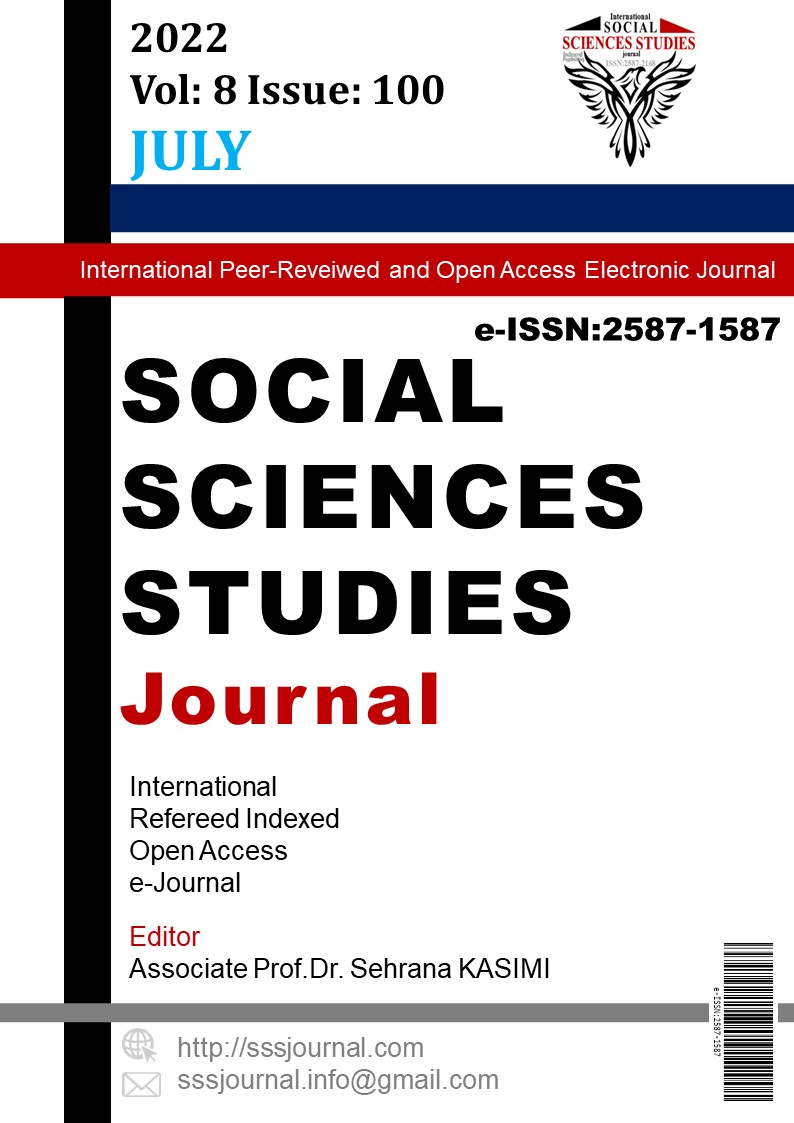Author :
Abstract
Sağlık göstergeleri toplumun sağlık düzeyini gösteren parametrelerdir. Bu araştırmanın amacı, 2019 yılı OECD sağlık göstergelerinin sağlık sonuçlarına etkisinin yapısal eşitlik modeli ile analiz edilmesidir. Veriler OECD tarafından yayınlanan Bir Bakışta Sağlık araştırma raporundan alınmıştır. Araştırmada seçilen sağlık göstergeleri 1000 kişiye düşen hemşire ve hekim sayısı, doğumda beklenen yaşam süresi, 100.000 kişi başına düşen ölüm oranı, sağlık harcaması ve satın alma paritesine göre kişi başı sağlık harcamasıdır. Bu boyutlardaki veriler farklı ölçüm oranlarına sahip olduğundan standartlaştırılmış z değerleri alınmıştır. SPSS Versiyon 24 ve AMOS Versiyon 23 programı kullanılarak yapısal eşitlik modellemesi yol analizi ile test edilmiştir. Sağlık harcamalarını hemşire ve hekim sayısı pozitif, satın alma paritesine göre kişi başı sağlık harcaması ise negatif etkilemektedir. Path modeli doğrudan etkiler açısından değerlendirildiğinde hekim sayısının (1,72) sağlık harcamaları üzerinde en yüksek etkiye sahip olduğu belirlenmiştir. Modele göre sağlık harcamalarına etkisi en düşük olan kişi başına düşen satın alma paritesine (-0,03) gore sağlık harcamalarıdır.
Keywords
Abstract
Health indicators are the parameters that show the health level of society. The research is to analyze the impact of OECD health indicators on health outcomes by using the structural equality model. The are taken from the OECD's Health at a Glance research report. The indicators are the number of nurses and physicians per 1000 people, life expectancy at birth and the death rate per 100.000 people, health expenditure, per capita health expenditure. The data in these dimensions have different measurement rates were taken standardized z values. Structural equation modeling was tested with path analysis using SPSS Version 24 and AMOS Version 23 programs. The number of nurses and doctors positively, per capita health expenditure negatively affects health expenditures. When the path model was evaluated in terms of direct effects, it was determined that the number of doctors (1,72) had the highest effect on health expenditures. According to the model, per capita health expenditure (-0,03) has the lowest effect on health expenditures
Keywords
- 1. Akçay, A. & Erataş, F. (2015). “Satın Alma Gücü Paritesi Teorisinin Geçerliliği: G7 örneği”, İstanbul Gelişim Üniversitesi Sosyal Bilimler Dergisi, 2(1): 81-100.
- 2. Arı, H.O. (2018). Türkiye’de Sağlık Harcamaları: Ulusal Sağlık Hesapları Sonuçlarının Genel Değerlendirmesi 1999-2016. TÜSPE Yayınları, Ankara.
- 3. Aydın, B. (2020). “İktisadi Göstergelerin Beklenen Yaşam Süresi Üzerindeki Etkileri: Panel Veri Analizi”, İstanbul İktisat Dergisi, 70(1): 163-181.
- 4. Bayram, N. (2013). Yapısal Eşitlik Modellemesine Giriş AMOS Uygulamaları, Ezgi Kitapevi, Bursa.
- 5. Boz, C., Taş, N. & Önder, E. (2020). “The Impacts of Aging, Income and Urbanization on Health Expenditures: A Panel Regression Analysis for OECD countries”, Turkish Journal of Public Health, 18(1):1-9.
- 6. Çelebi, A. & Cura, S. (2013). “Etkinlik Göstergeleri Açısından Sağlık Sistemleri: Karşılaştırmalı Bir Analiz”, Maliye Dergisi, 164: 47-67.
- 7. Çetintürk, İ. & Gençtürk, M. (2020). “OECD Ülkelerinin Sağlık Harcama Göstergelerinin Kümeleme Analizi İle Sınıflandırılması”, Süleyman Demirel Üniversitesi Vizyoner Dergisi, 11(26): 228-244.
- 8. Çevik, S. (2013). “Kamu Sağlık Harcamalarının Sağlık Sonuçları Üzerindeki Etkisi: Ülkelerin Gelir Seviyelerine Göre Bir Karşılaştırma”, İ.Ü. Siyasal Bilgiler Fakültesi Dergisi, 48: 113-133.
- 9. Çokluk, Ö., Şekercioğlu, G. & Büyüköztürk, Ş. (2014). Sosyal Bilimler için Çok Değişkenli İstatistik SPSS ve LISREL Uygulamaları, Pegem Akademi Yayınları, Ankara.
- 10. Demir, A. & Bakırcı, F. (2014). “OECD Üyesi Ülkelerin Ekonomik Etkinliklerinin Veri Zarflama Analiziyle Ölçümü”, Atatürk Üniversitesi İktisadi ve İdari Bilimler Dergisi, 28(2): 109-132.
- 11. Gökkaya, D., Şenol, O. & Çıraklı, Ü. (2021). “Investigation of the Effect of R&D, Education and Health Expenditures on Economic Growth by Panel Data Analysis Method”, Sosyoekonomi, 29 (50): 95-108.
- 12. Güleryüz, E. H. & Köse, T. (2017). “İşsizlik ve Sağlık Göstergeleri: Türkiye Örneği”, Finans Politik ve Ekonomik Yorumlar, (633): 27-39
- 13. Jaba, E., Brigitte Balan, C. & Robu, I-B. (2014). “The Relationship Between Life Expectancy at Birth and Health Expenditures Estimated by a Cross-country and Time-series analysis”, Procedia Economics and Finance, 15: 108-114.
- 14. Kocaman, A.M., Mutlu, M.E., Bayraktar, D. & Araz, Ö. M. (2012). “OECD Ülkelerinin Sağlık Sistemlerinin Etkinlik Analizi”, Endüstri Mühendisliği Dergisi, 23(4):14-31.
- 15. Köksal, S., Sipahioğlu, N. T., Yurtsever, E. & Vehid, S. (2016). “Temel Sağlık Düzeyi Göstergeleri Açısından Türkiye ve Avrupa Birliği Ülkeleri”, Turkish Journal of Family Medicine and Primary Care, 10(4): 205-212.
- 16. Larson, C. & Mercer, A. (2004). “Global Health Indicators: An Overview”, Canadian Medical Association Journal, (171):1199-1200.
- 17. Meydan, C. H. & Şeşen, H. (2011). Yapısal Eşitlik Modellemesi AMOS Uygulamaları, Detay Yayıncılık, Ankara.
- 18. Monsef, A. & Mehrjardi, A. S. (2015). “Determinants of Life Expectancy: A Panel Data Approach”, Asian Economic and Financial Review, 5(11): 1251-1257.
- 19. OECD (2021). Health at a Glance 2021: OECD Indicators, OECD Publishing, Paris.
- 20. Özgen, H. (2007). “Sağlık Hizmetleri Finansmanında Cepten Harcama: Nedir?Neden önemlidir?”, Hacettepe Sağlık İdaresi Dergisi, 10(2): 201-228.
- 21. Parkin, D., McGuire, A. & Yule, B. (1987), “Aggregate Health Expenditures and National Income Is Health Care a Luxury Good?”, Journal of Health Economics, 6: 109-127.
- 22. Sayılı, U. (2017). “Türkiye ve OECD Ülkelerinin Sağlık Göstergeleri ve Sağlık Harcamalarının Karşılaştırılması”, Online Türk Sağlık Bilimleri Dergisi, 1–12.
- 23. Schermelleh-Engel, K., Moosbrugger, H., & Müller, H. (2003). “Evaluating The Fit of Structural Equation Models: Tests of Significance and Descriptive Goodness-of-Fit Measures”, Methods of psychological research, 8(2): 23-74.
- 24. Şener, M. & Yiğit V. (2017). “Sağlık Sistemlerinin Teknik Verimliliği: OECD Ülkeleri Üzerinde Bir Araştırma”, Süleyman Demirel Üniversitesi Sosyal Bilimler Enstitüsü Dergisi, 26: 66-290.





